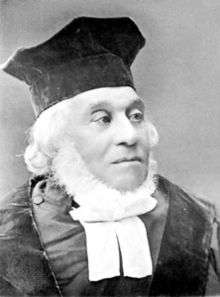Nathan Marcus Adler
| Chief Rabbi Nathan Marcus Adler | |
|---|---|
| Chief Rabbi of the British Empire | |
 | |
| Position | Chief Rabbi |
| Began | 13 October 1844 |
| Ended | 21 January 1890 |
| Predecessor | Solomon Hirschell |
| Successor | Hermann Adler |
| Personal details | |
| Born |
13 January 1803 Hanover, Electorate of Hanover |
| Died |
21 January 1890 (aged 87) Brighton, United Kingdom |

Rabbi Nathan Marcus HaKohen Adler (13 January 1803 – 21 January 1890) (Hebrew name: Natan ben Mordechai ha-Kohen) was the Orthodox Chief Rabbi of the British Empire from 1845 until his death.
Life
A kohen by birth, Rabbi Nathan was born in Hanover, in present-day Germany. He was apparently named after the kabbalist Nathan Adler (according to the biography of the latter in the Jewish Encyclopedia). His distant relative Jacob Adler, who made his acquaintance in the winter of 1883–1884, described him as the "highest religious authority not only of London Jews but of all Orthodox Jews throughout the United Kingdom and the Empire." He subscribed to what was known as the Frankfurter Orthodoxy.
Whilst Rabbi in Hanover, he became acquainted with Prince Adolphus, Duke of Cambridge, regent of the province, who is thought to have recommended him for the post of Chief Rabbi in Britain.[1]
Out of 13 candidates, mostly from Germany, he made the short list of four for the post of Chief Rabbi of the British Empire. The three others were: Samson Raphael Hirsch, Benjamin Hirsch Auerbach, Hirsch Hirschfeld. With 135 communities voting having one vote each, on 1 December 1844, Adler received 121 votes, Hirschfeld 12, and Hirsch 2.[2]
The first university-educated British Chief Rabbi, and the first to undertake regular pastoral tours within the United Kingdom, he was also a founder of the National Society for the Prevention of Cruelty and Better Protection of Children. His period as Chief Rabbi saw the completion of the emancipation of Jews within the United Kingdom; the election (1847) and seating (1858) of Lionel de Rothschild as the first Jewish member of parliament; Nathan Mayer Rothschild's ascent as the first Jewish member of the House of Lords (1885); and Sir David Salomons's term as the first Jewish Lord Mayor of London (1855).
Adler was instrumental in bringing together the United Synagogue, established by Act of Parliament in 1870. As of 2006, this remains the largest religious grouping within the British Jewish community, and takes its religious authority from the Chief Rabbi.
Adler was also involved in scholarly activities such as writing, editing, and translating. For instance, in 1907 his critical text, translation, and commentary of Benjamin of Tudela's important medieval manuscript, The Itinerary of Benjamin of Tudela, was published. His monumental work is the commentary Netinah LaGer on the Targum Onkelos, an Aramaic version of the Torah.[3]
Adler is buried at the US (United Synagogue) cemetery in Willesden.
Legacy
Adler Street, in London E1, was named after him; the Jewish Institute (a reading-room) and two synagogues formerly stood there, until the area was destroyed in The Blitz. Adler's son Hermann Adler was also a distinguished rabbi: head of a congregation in Bayswater during his father's lifetime, Adler's assistant from the time Adler's health began to deteriorate in 1879, and his successor as Chief Rabbi.
References
Notes
- ↑ Roger Fulford, Royal Dukes, London (1973), p. 295.
- ↑ Stephen Gabriel Rosenberg. Guest Columnist: Samson Raphael: The British connection. The Jerusalem Post, June 12, 2008 Hirsch:
- ↑ http://www.oztorah.com/2009/08/nathan-marcus-adler-chief-rabbi/ Rabbi Raymond Apple's biographical essay on Chief Rabbi Adler
Sources
- Adler, Jacob (1999). A Life on the Stage: A Memoir. Translated and with commentary by Lulla Rosenfeld. New York: Knopf. pp. 233–234. ISBN 0-679-41351-0.
 Carlyle, Edward Irving (1901). "Adler, Nathan Marcus". In Sidney Lee. Dictionary of National Biography, 1901 supplement. London: Smith, Elder & Co.
Carlyle, Edward Irving (1901). "Adler, Nathan Marcus". In Sidney Lee. Dictionary of National Biography, 1901 supplement. London: Smith, Elder & Co. - Deutsch, Gotthard, Adler, Nathan, Jewish Encyclopedia (1901–1906); on the kabbalist Adler, says that Nathan Marcus Adler was named after him.
- Kirk, John Foster (1891). "Adler, Nathan Marcus (1803-1890)". A Supplement to Allibone's Critical Dictionary of English Literature and British and American Authors. Philadelphia: J. B. Lippincott Company.
- Lipkind, Goodman, Adler, Nathan Marcus, Jewish Encyclopedia (1901–1906).
- Sanders, Lloyd C. (1887). "Adler, Nathan Marcus (1803-)". Celebrities of the Century: Being a Dictionary of Men and Women of the Nineteenth Century. London: Cassell & Co.
- Schmidt, Helmut Dan (1962). Chief Rabbi Nathan Marcus Adler (1803–1890): Jewish Educator from Germany. London: Leo Baeck Institute.
- "Nathan Marcus Adler". Chief Rabbi of Britain.
External links
- Nathan Adler's Photo & Gravesite
- Article on the British Chief Rabbinate
- Biography of Rabbi Nathan Marcus Adler
| Jewish titles | ||
|---|---|---|
| Preceded by Solomon Hirschell |
Chief Rabbi of Great Britain 1845–1890 |
Succeeded by Hermann Adler |